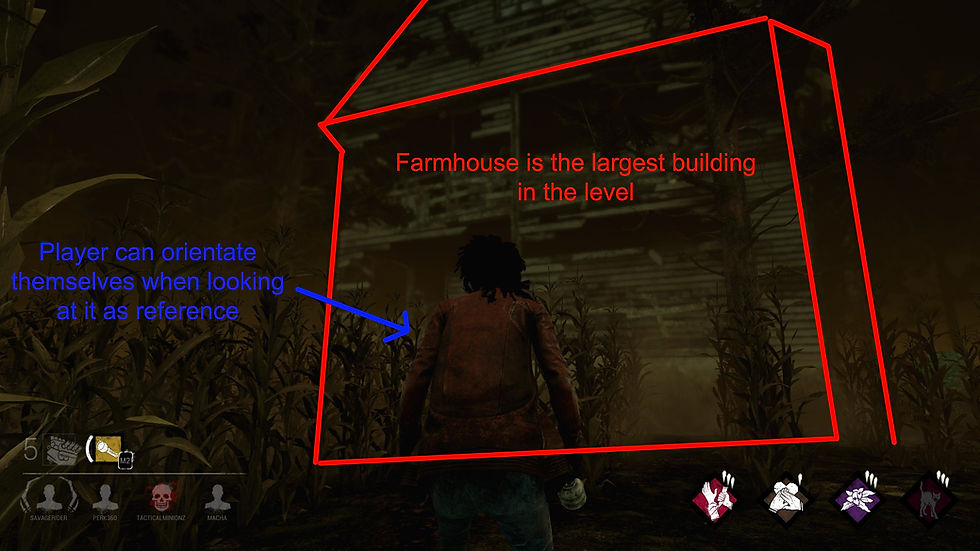Dead by Daylight: How the level design adds to the horror experience.
This is a paper written as part of my university training in games design.
Abstract
Dead by Daylight is an asymmetric survival horror game that pits four survivors against one killer. Survivors must escape the level and can only move and interact with the environment.
Defining level design
Before we begin let's define what level design is in relation to this article.
Level Design: Concept, Theory & Practice states “level design is applied game design”, (Kremers, 2009). This would infer that level design is the practical way of implementing game design ideas.
Story and environment
Clichés are found in the design of Coldwind Farm as they have psychological triggers that make the player react and are proven to work (Alex galuzin, 2009).

Fig 1
Coldwind farm is set at night time on an abandoned farm (fig 1). The survivors are trying to escape a serial killer who is trying to sacrifice them to an entity (Deadbydaylightcom, 2016). This story and environment have been used previously in horror because the format works and this is why it was used in Coldwind Farm. Using clichés produces psychological effects on the player even before the killer begins to chase them and this in turn triggers the player’s survival instincts.
Critical Path
The survivor objective is to repair 5 generators (Fig 2) to open the doors to escape the level. This can be defined as the level’s critical path.

Fig 2
According to Game Design: Theory and Practice, the critical path gives the players a direction or goal in order to complete the level (Rouse iii, 2005). This is known as the shortest path from level start to finish.
The Critical path illustrated in Fig 3.

Fig 3
However, the critical path can be interrupted at any time when the killer approaches a survivor as they have to run and hide (Fig 4)

Fig 4
Core beats
The level is designed for asymmetric or random gameplay however the core beats between the survivor can be illustrated (Fig 5)

Fig 5
Prospect spaces
Coldwind Farm is an Island in its design (Fig 6) as there is space for players to choose how they experience the level (Rogers, 2014).

Fig 6
There is a lot of prospect space used in this level (Fig 7) as it is designed to make the survivors feel vulnerable (Totten, 2016)

Fig 7
The level contains refuges where players can hide (Fig 8)

Fig 8
A refuge allows players to check their surroundings for danger. Totten (2016) states that a human’s natural instinct is to hide in order to survive so the level design provides the player the means to hide from threats.
Lighting
Coldwind Farm is dark with ambient lighting which is consistently seen in the horror genre. Light is also designed so that generators can be seen by the players (Fig 9)

Fig 9
Level design states “light is often used to create a sense of safety”, (Kremers, 2009). However, when a generator is repaired the area becomes well lit making players easily seen by the killer. In a reversal darkness then becomes a place of refuge rather than light for players adding to the horror of the game.
“Weenie”
The level contains a “Weenie”, the farmhouse (fig 10).

Fig 10
Level Up! states that “weenies” are used to gain interest and draw players in their direction and can be buildings (Rogers, 2014) in this case, the farmhouse. The weenie can also draw the player to it to satisfy their curiosity.
Level aesthetics
In terms of aesthetics, survivors are circular and placed in a triangular environment (Fig 11 & 12)

Fig 11

Fig 12
The environment shapes are all triangular giving it an aggressive appearance which contrasts with the player character who is circular in shape giving a sense of dissonance or tension. The killer in Fig 11 is triangular in contrast to the survivor adding to the tension of the game.
Moral Decisions and Relationships
When a survivor in the level is caught and placed on a hook (Fig 13) other players may attempt to rescue them. This presents a player with the moral decision on whether to attempt rescue and risk danger to themselves.

Fig 13
Giving players decisions makes the level design unique as gameplay is decided by the player, (Alex Galuzin, 2009). Relationships between players can influence decisions. If a player is teamed with a friend then they may attempt rescue but if it is too dangerous they are faced with the moral decision of sacrificing their friend to save themselves.
Summary
Overall Coldwind Farm has a psychological impact on the player to make them feel like they’re in a horror game by the use of the elements discussed above. These elements help to trigger the player’s survival instincts and by doing so makes them react and behave to how they would in the real world making the level design suited for horror.
References
Kremers, R.K. (2009). Level Design: Concept Theory & Practice. United States of America: A K Peters Ltd.
Alex galuzin, A.G. (2009). Worldofleveldesigncom. Retrieved 6 December, 2016, from http://www.worldofleveldesign.com/categories/level_design_tutorials/horror-fear-level-design/part1-survival-horror-level-design-cliches.php
Deadbydaylightcom. (2016). Deadbydaylightcom. Retrieved 29 November, 2016, from http://www.deadbydaylight.com/manual/lore/
Rouse iii, R.R. (2005). Game Design: Theory and Practice. (2nd ed.). United States of America: Jones and Bartlett Publishers.
Rogers, S.R. (2014). Level Up!. (2nd ed.). United Kingdom: John Wiley & Sons Ltd.
Totten, C.W.T. (2016). Designing Better Levels Through Human Survival Instincts. Retrieved 29 November, 2016, from http://www.gamasutra.com/view/feature/6411/designing_better_levels_through_.php?print=1
Bibliography
http://www.worldofleveldesign.com/categories/level_design_tutorials/horror-fear-level-design/part2-survival-horror-level-design-anticipation-pacing.php
Image sources
http://www.deadbydaylight.com/wpcontent/uploads/2016/04/DBD_Standard_Edition-1024x560.jpg






